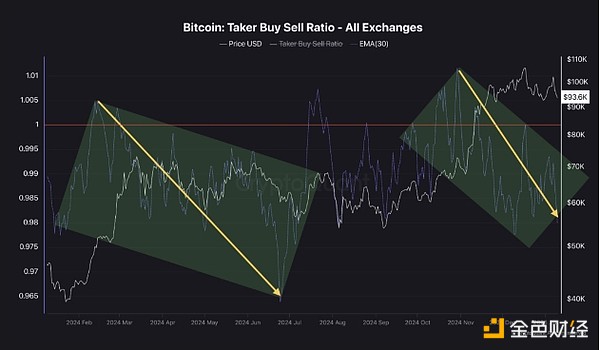Author: Biraajmaan Tamuly, CoinTelegraph; Compiled by Wuzhu, Golden Finance
BTC’s daily chart has been bearish for three consecutive days as the largest crypto asset fell to nearly $92,000 on January 9. The overall investor sentiment was further dampened by the fact that the spot Bitcoin ETF saw the second-highest net outflow of $569.1 million on January 9 after the U.S. Department of Justice (DOJ) approved the sale of 69,000 BTC worth more than $6.5 billion.
As questions like “Is the Bitcoin bull run over?” begin to appear on X, one analyst said that bullish optimism for BTC should remain intact.
News-Inspired Volatility Plagues Bitcoin Price
Bitcoin’s recent decline was largely driven by uncertainty over the Federal Reserve’s rate cuts and investors’ cautious approach ahead of President-elect Trump’s inauguration. On-chain data clearly highlights this sentiment, as the 30-day moving average of the taker buy/sell ratio indicates seller dominance for the first time since March 2024, when BTC peaked at around $74,000.

Bitcoin Taker Buy/Sell Ratio. Source: CryptoQuant
Bitcoin’s Short-Term Spend-Output Profit Ratio (SOPR) also fell below 1, meaning short-term investors are selling at a low price. However, anonymous crypto analyst Avocado onchain said that these changes are part of BTC’s short-term volatility caused by market speculation rather than changes in market structure. The trader added,
“Investors should remain strategic, avoid reacting to short-term noise, and focus on the broader bullish trajectory,”
Similarly, crypto trader Mikybull pointed out a list of key Bitcoin top signals for the current bull cycle. Out of 30 possible market top indicators, including the Puell Multiple, RSI-22 day, Bitcoin Dominance, and MVRV ratio, none of the signals have been hit in the current cycle. "Every dip is an opportunity to prepare for the massive rally that's coming," the trader said. Bitcoin bull peak indicator list. Source: CoinGlass Cryptocurrency analyst Alex Kruger also dismissed the long-term bearish dilemma, saying "people are too pessimistic right now."
The economist explained that while the “easy mode” is over in the future, the liquidity that will be injected into traditional finance in 2025 has not yet been taken into account.
 Weiliang
Weiliang







